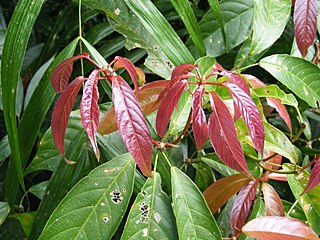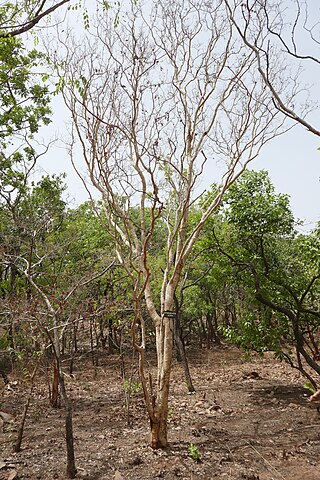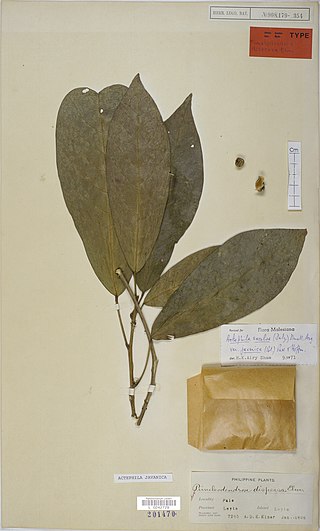
Antidesma is a genus of tropical plant in the family Phyllanthaceae formally described by Linnaeus in 1753. It is native to tropical Africa, S + E + SE Asia, Australia, and various oceanic islands. The greatest diversity occurs in Southeast Asia.

Sampantaea amentiflora is a plant species of the family Euphorbiaceae, first described as a genus in 1972. The genus Sampantaea is monotypic and found in Thailand and Cambodia.

Rockinghamia is a plant genus of the spurge family (Euphorbiaceae), first described as a genus in 1966. The entire genus is endemic to the State of Queensland in Australia.
- Rockinghamia angustifolia(Benth.) Airy Shaw
- Rockinghamia brevipesAiry Shaw
Cleidiocarpon is a genus of plant of the family Euphorbiaceae first described as a genus in 1965. It is native to China and Indochina.
- Cleidiocarpon cavaleriei(H.Lév.) Airy Shaw - Yunnan, Guizhou, Guangxi, Vietnam
- Cleidiocarpon laurinumAiry Shaw - Thailand, Myanmar

Koilodepas is a genus of plant of the family Euphorbiaceae first described as a genus in 1856. It is native to Southeast Asia, India, Hainan, and New Guinea.
Hylandia is a genus of plants, of the family Euphorbiaceae, named in honour of Australian botanist Bernie Hyland, by Herbert K. Airy Shaw.
Myricanthe is a genus of plants in the family Euphorbiaceae first described as a genus in 1980. It has only one known species, Myricanthe discolor, endemic to New Caledonia.
Stachyandra is a plant genus in the family Picrodendraceae first described as a genus in 1990.

Bischofia is a genus of plants in the family Phyllanthaceae first described as a genus in 1827. It is native to southern China, the Indian Subcontinent, Queensland, New Guinea, and various islands of the Pacific. It is the only member of the tribe Bischofieae. They are dioecious, with male and female flowers on separate plants, but may rarely be monoecious.
Leptonema is a genus of flowering plant belonging to the family Phyllanthaceae first described in 1824. The entire genus is endemic to Madagascar. It is dioecious, with male and female flowers on separate plants.
- Leptonema glabrum(Leandri) Leandri
- Leptonema venosum(Poir.) A.Juss.
Ashtonia is a genus of flowering plant belonging to the family Phyllanthaceae first described as a genus in 1968. It is native to the Malay Peninsula and Borneo. It is dioecious, with male and female flowers on separate plants.
- Ashtonia excelsa Airy Shaw - Borneo
- Ashtonia praeterita Airy Shaw - S Thailand, W Malaysia

Baccaurea is a genus of flowering plants belonging to the family Phyllanthaceae. The genus comprises 51 species, distributed from India to Indochina, southern China, Malesia, New Guinea, and the West Pacific. It is dioecious, with male and female flowers on separate plants. Many species contain edible fruits.

Richeria is a genus of flowering plant belonging to the family Phyllanthaceae first described as a genus in 1797. It is native to Central America, South America, and the West Indies. Richeria is dioecious, with male and female flowers on separate plants.
- Richeria australis - São Paulo, Mato Grosso
- Richeria dressleri - Costa Rica, Nicaragua, Panama, Ecuador
- Richeria grandis - Panama, N South America, E West Indies
- Richeria obovata - Costa Rica to Bolivia
- Richeria tomentosa - Colombia, Ecuador

Uapaca is a genus of plant, in the family Phyllanthaceae first described as a genus in 1858. It is the only genus comprised in the tribe Uapaceae. The genus is native to Africa and Madagascar. Uapaca is dioecious, with male and female flowers on separate plants.

Hymenocardia is a genus of trees in the family Phyllanthaceae first described as a genus in 1836. Most of the species are native to Africa, with one in Southeast Asia.

Breynia is a genus in the flowering plant family Phyllanthaceae, first described in 1776. It is native to Southeast Asia, China, Réunion, the Indian Subcontinent, Papuasia and Australia.

Glochidion is a genus of flowering plants, of the family Phyllanthaceae, known as cheese trees or buttonwood in Australia, and leafflower trees in the scientific literature. It comprises about 300 species, distributed from Madagascar to the Pacific Islands. Glochidion species are used as food plants by the larvae of some Lepidoptera species including Aenetus eximia and Endoclita damor. The Nicobarese people have attested to the medicinal properties found in G. calocarpum, saying that its bark and seed are most effective in curing abdominal disorders associated with amoebiasis.

Actephila is a genus of plants in the family Phyllanthaceae, first described as a genus in 1826. It is one of 8 genera in the tribe Poranthereae, and is most closely related to Leptopus. The name of the genus is derived from two Greek words, akte, "the seashore", and philos, "loving". It refers to a coastal habitat.

Lachnostylis is a genus of the family Phyllanthaceae first described as a genus in 1846. It is native to the Eastern Cape and the Western Cape Provinces of South Africa. It is often included in Savia. It is dioecious, with male and female flowers on separate plants.
- Lachnostylis bilocularisR.A.Dyer
- Lachnostylis hirta(L.f.) Müll.Arg.

Cleistanthus hylandii, commonly known as Bernie's Cleistanthus, is an evergreen plant in the family Phyllanthaceae which is endemic to Cape York Peninsula in far northern Queensland, Australia.













